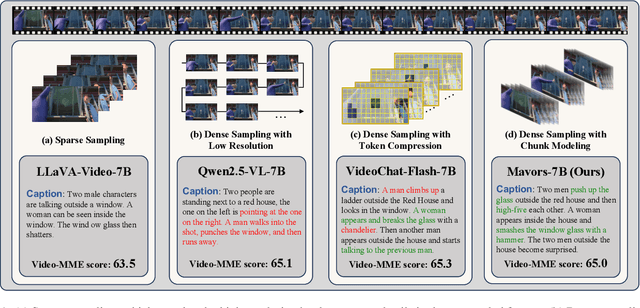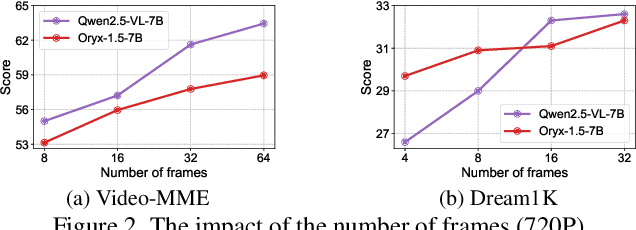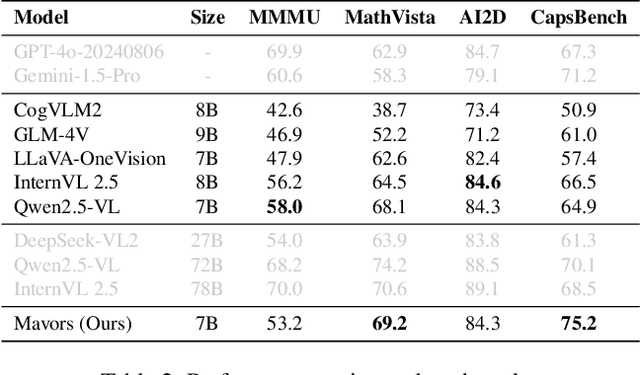Bohan Zeng
Rethinking Driving World Model as Synthetic Data Generator for Perception Tasks
Oct 22, 2025Abstract:Recent advancements in driving world models enable controllable generation of high-quality RGB videos or multimodal videos. Existing methods primarily focus on metrics related to generation quality and controllability. However, they often overlook the evaluation of downstream perception tasks, which are $\mathbf{really\ crucial}$ for the performance of autonomous driving. Existing methods usually leverage a training strategy that first pretrains on synthetic data and finetunes on real data, resulting in twice the epochs compared to the baseline (real data only). When we double the epochs in the baseline, the benefit of synthetic data becomes negligible. To thoroughly demonstrate the benefit of synthetic data, we introduce Dream4Drive, a novel synthetic data generation framework designed for enhancing the downstream perception tasks. Dream4Drive first decomposes the input video into several 3D-aware guidance maps and subsequently renders the 3D assets onto these guidance maps. Finally, the driving world model is fine-tuned to produce the edited, multi-view photorealistic videos, which can be used to train the downstream perception models. Dream4Drive enables unprecedented flexibility in generating multi-view corner cases at scale, significantly boosting corner case perception in autonomous driving. To facilitate future research, we also contribute a large-scale 3D asset dataset named DriveObj3D, covering the typical categories in driving scenarios and enabling diverse 3D-aware video editing. We conduct comprehensive experiments to show that Dream4Drive can effectively boost the performance of downstream perception models under various training epochs. Project: $\href{https://wm-research.github.io/Dream4Drive/}{this\ https\ URL}$
MorphoBench: A Benchmark with Difficulty Adaptive to Model Reasoning
Oct 16, 2025Abstract:With the advancement of powerful large-scale reasoning models, effectively evaluating the reasoning capabilities of these models has become increasingly important. However, existing benchmarks designed to assess the reasoning abilities of large models tend to be limited in scope and lack the flexibility to adapt their difficulty according to the evolving reasoning capacities of the models. To address this, we propose MorphoBench, a benchmark that incorporates multidisciplinary questions to evaluate the reasoning capabilities of large models and can adjust and update question difficulty based on the reasoning abilities of advanced models. Specifically, we curate the benchmark by selecting and collecting complex reasoning questions from existing benchmarks and sources such as Olympiad-level competitions. Additionally, MorphoBench adaptively modifies the analytical challenge of questions by leveraging key statements generated during the model's reasoning process. Furthermore, it includes questions generated using simulation software, enabling dynamic adjustment of benchmark difficulty with minimal resource consumption. We have gathered over 1,300 test questions and iteratively adjusted the difficulty of MorphoBench based on the reasoning capabilities of models such as o3 and GPT-5. MorphoBench enhances the comprehensiveness and validity of model reasoning evaluation, providing reliable guidance for improving both the reasoning abilities and scientific robustness of large models. The code has been released in https://github.com/OpenDCAI/MorphoBench.
Native Visual Understanding: Resolving Resolution Dilemmas in Vision-Language Models
Jun 15, 2025



Abstract:Vision-Language Models (VLMs) face significant challenges when dealing with the diverse resolutions and aspect ratios of real-world images, as most existing models rely on fixed, low-resolution inputs. While recent studies have explored integrating native resolution visual encoding to improve model performance, such efforts remain fragmented and lack a systematic framework within the open-source community. Moreover, existing benchmarks fall short in evaluating VLMs under varied visual conditions, often neglecting resolution as a critical factor. To address the "Resolution Dilemma" stemming from both model design and benchmark limitations, we introduce RC-Bench, a novel benchmark specifically designed to systematically evaluate VLM capabilities under extreme visual conditions, with an emphasis on resolution and aspect ratio variations. In conjunction, we propose NativeRes-LLaVA, an open-source training framework that empowers VLMs to effectively process images at their native resolutions and aspect ratios. Based on RC-Bench and NativeRes-LLaVA, we conduct comprehensive experiments on existing visual encoding strategies. The results show that Native Resolution Visual Encoding significantly improves the performance of VLMs on RC-Bench as well as other resolution-centric benchmarks. Code is available at https://github.com/Niujunbo2002/NativeRes-LLaVA.
VersaVid-R1: A Versatile Video Understanding and Reasoning Model from Question Answering to Captioning Tasks
Jun 10, 2025Abstract:Recent advancements in multimodal large language models have successfully extended the Reason-Then-Respond paradigm to image-based reasoning, yet video-based reasoning remains an underdeveloped frontier, primarily due to the scarcity of high-quality reasoning-oriented data and effective training methodologies. To bridge this gap, we introduce DarkEventInfer and MixVidQA, two novel datasets specifically designed to stimulate the model's advanced video understanding and reasoning abilities. DarkEventinfer presents videos with masked event segments, requiring models to infer the obscured content based on contextual video cues. MixVidQA, on the other hand, presents interleaved video sequences composed of two distinct clips, challenging models to isolate and reason about one while disregarding the other. Leveraging these carefully curated training samples together with reinforcement learning guided by diverse reward functions, we develop VersaVid-R1, the first versatile video understanding and reasoning model under the Reason-Then-Respond paradigm capable of handling multiple-choice and open-ended question answering, as well as video captioning tasks. Extensive experiments demonstrate that VersaVid-R1 significantly outperforms existing models across a broad spectrum of benchmarks, covering video general understanding, cognitive reasoning, and captioning tasks.
Multi-Step Visual Reasoning with Visual Tokens Scaling and Verification
Jun 08, 2025Abstract:Multi-modal large language models (MLLMs) have achieved remarkable capabilities by integrating visual perception with language understanding, enabling applications such as image-grounded dialogue, visual question answering, and scientific analysis. However, most MLLMs adopt a static inference paradigm, encoding the entire image into fixed visual tokens upfront, which limits their ability to iteratively refine understanding or adapt to context during inference. This contrasts sharply with human perception, which is dynamic, selective, and feedback-driven. In this work, we introduce a novel framework for inference-time visual token scaling that enables MLLMs to perform iterative, verifier-guided reasoning over visual content. We formulate the problem as a Markov Decision Process, involving a reasoner that proposes visual actions and a verifier, which is trained via multi-step Direct Preference Optimization (DPO), that evaluates these actions and determines when reasoning should terminate. To support this, we present a new dataset, VTS, comprising supervised reasoning trajectories (VTS-SFT) and preference-labeled reasoning comparisons (VTS-DPO). Our method significantly outperforms existing approaches across diverse visual reasoning benchmarks, offering not only improved accuracy but also more interpretable and grounded reasoning processes. These results demonstrate the promise of dynamic inference mechanisms for enabling fine-grained, context-aware visual reasoning in next-generation MLLMs.
MME-VideoOCR: Evaluating OCR-Based Capabilities of Multimodal LLMs in Video Scenarios
May 27, 2025Abstract:Multimodal Large Language Models (MLLMs) have achieved considerable accuracy in Optical Character Recognition (OCR) from static images. However, their efficacy in video OCR is significantly diminished due to factors such as motion blur, temporal variations, and visual effects inherent in video content. To provide clearer guidance for training practical MLLMs, we introduce the MME-VideoOCR benchmark, which encompasses a comprehensive range of video OCR application scenarios. MME-VideoOCR features 10 task categories comprising 25 individual tasks and spans 44 diverse scenarios. These tasks extend beyond text recognition to incorporate deeper comprehension and reasoning of textual content within videos. The benchmark consists of 1,464 videos with varying resolutions, aspect ratios, and durations, along with 2,000 meticulously curated, manually annotated question-answer pairs. We evaluate 18 state-of-the-art MLLMs on MME-VideoOCR, revealing that even the best-performing model (Gemini-2.5 Pro) achieves an accuracy of only 73.7%. Fine-grained analysis indicates that while existing MLLMs demonstrate strong performance on tasks where relevant texts are contained within a single or few frames, they exhibit limited capability in effectively handling tasks that demand holistic video comprehension. These limitations are especially evident in scenarios that require spatio-temporal reasoning, cross-frame information integration, or resistance to language prior bias. Our findings also highlight the importance of high-resolution visual input and sufficient temporal coverage for reliable OCR in dynamic video scenarios.
Let's Verify Math Questions Step by Step
May 20, 2025Abstract:Large Language Models (LLMs) have recently achieved remarkable progress in mathematical reasoning. To enable such capabilities, many existing works distill strong reasoning models into long chains of thought or design algorithms to construct high-quality math QA data for training. However, these efforts primarily focus on generating correct reasoning paths and answers, while largely overlooking the validity of the questions themselves. In this work, we propose Math Question Verification (MathQ-Verify), a novel five-stage pipeline designed to rigorously filter ill-posed or under-specified math problems. MathQ-Verify first performs format-level validation to remove redundant instructions and ensure that each question is syntactically well-formed. It then formalizes each question, decomposes it into atomic conditions, and verifies them against mathematical definitions. Next, it detects logical contradictions among these conditions, followed by a goal-oriented completeness check to ensure the question provides sufficient information for solving. To evaluate this task, we use existing benchmarks along with an additional dataset we construct, containing 2,147 math questions with diverse error types, each manually double-validated. Experiments show that MathQ-Verify achieves state-of-the-art performance across multiple benchmarks, improving the F1 score by up to 25 percentage points over the direct verification baseline. It further attains approximately 90% precision and 63% recall through a lightweight model voting scheme. MathQ-Verify offers a scalable and accurate solution for curating reliable mathematical datasets, reducing label noise and avoiding unnecessary computation on invalid questions. Our code and data are available at https://github.com/scuuy/MathQ-Verify.
Mavors: Multi-granularity Video Representation for Multimodal Large Language Model
Apr 14, 2025



Abstract:Long-context video understanding in multimodal large language models (MLLMs) faces a critical challenge: balancing computational efficiency with the retention of fine-grained spatio-temporal patterns. Existing approaches (e.g., sparse sampling, dense sampling with low resolution, and token compression) suffer from significant information loss in temporal dynamics, spatial details, or subtle interactions, particularly in videos with complex motion or varying resolutions. To address this, we propose $\mathbf{Mavors}$, a novel framework that introduces $\mathbf{M}$ulti-gr$\mathbf{a}$nularity $\mathbf{v}$ide$\mathbf{o}$ $\mathbf{r}$epre$\mathbf{s}$entation for holistic long-video modeling. Specifically, Mavors directly encodes raw video content into latent representations through two core components: 1) an Intra-chunk Vision Encoder (IVE) that preserves high-resolution spatial features via 3D convolutions and Vision Transformers, and 2) an Inter-chunk Feature Aggregator (IFA) that establishes temporal coherence across chunks using transformer-based dependency modeling with chunk-level rotary position encodings. Moreover, the framework unifies image and video understanding by treating images as single-frame videos via sub-image decomposition. Experiments across diverse benchmarks demonstrate Mavors' superiority in maintaining both spatial fidelity and temporal continuity, significantly outperforming existing methods in tasks requiring fine-grained spatio-temporal reasoning.
WideRange4D: Enabling High-Quality 4D Reconstruction with Wide-Range Movements and Scenes
Mar 17, 2025



Abstract:With the rapid development of 3D reconstruction technology, research in 4D reconstruction is also advancing, existing 4D reconstruction methods can generate high-quality 4D scenes. However, due to the challenges in acquiring multi-view video data, the current 4D reconstruction benchmarks mainly display actions performed in place, such as dancing, within limited scenarios. In practical scenarios, many scenes involve wide-range spatial movements, highlighting the limitations of existing 4D reconstruction datasets. Additionally, existing 4D reconstruction methods rely on deformation fields to estimate the dynamics of 3D objects, but deformation fields struggle with wide-range spatial movements, which limits the ability to achieve high-quality 4D scene reconstruction with wide-range spatial movements. In this paper, we focus on 4D scene reconstruction with significant object spatial movements and propose a novel 4D reconstruction benchmark, WideRange4D. This benchmark includes rich 4D scene data with large spatial variations, allowing for a more comprehensive evaluation of the generation capabilities of 4D generation methods. Furthermore, we introduce a new 4D reconstruction method, Progress4D, which generates stable and high-quality 4D results across various complex 4D scene reconstruction tasks. We conduct both quantitative and qualitative comparison experiments on WideRange4D, showing that our Progress4D outperforms existing state-of-the-art 4D reconstruction methods. Project: https://github.com/Gen-Verse/WideRange4D
Any2AnyTryon: Leveraging Adaptive Position Embeddings for Versatile Virtual Clothing Tasks
Jan 27, 2025Abstract:Image-based virtual try-on (VTON) aims to generate a virtual try-on result by transferring an input garment onto a target person's image. However, the scarcity of paired garment-model data makes it challenging for existing methods to achieve high generalization and quality in VTON. Also, it limits the ability to generate mask-free try-ons. To tackle the data scarcity problem, approaches such as Stable Garment and MMTryon use a synthetic data strategy, effectively increasing the amount of paired data on the model side. However, existing methods are typically limited to performing specific try-on tasks and lack user-friendliness. To enhance the generalization and controllability of VTON generation, we propose Any2AnyTryon, which can generate try-on results based on different textual instructions and model garment images to meet various needs, eliminating the reliance on masks, poses, or other conditions. Specifically, we first construct the virtual try-on dataset LAION-Garment, the largest known open-source garment try-on dataset. Then, we introduce adaptive position embedding, which enables the model to generate satisfactory outfitted model images or garment images based on input images of different sizes and categories, significantly enhancing the generalization and controllability of VTON generation. In our experiments, we demonstrate the effectiveness of our Any2AnyTryon and compare it with existing methods. The results show that Any2AnyTryon enables flexible, controllable, and high-quality image-based virtual try-on generation.https://logn-2024.github.io/Any2anyTryonProjectPage/
 Add to Chrome
Add to Chrome Add to Firefox
Add to Firefox Add to Edge
Add to Edge